Evaluating Primary Health Care: A Case Study of Gnibi Healing Circle
VerifiedAdded on 2023/06/13
|10
|2358
|207
Report
AI Summary
This report analyzes the Gnibi Healing Circle in Kalumburu village as a primary health care program, focusing on social determinants of health such as social environment and support networks. It examines how the program addresses these determinants by fostering community and combating social isolation, referencing the Rural Health Education Foundation's video. The analysis highlights the program's alignment with primary health care principles, including intersectoral collaboration and community empowerment, through initiatives like family education and addressing mental health issues. The report further discusses the program's potential impact on mental health, a National Health Priority Area, by promoting social support and healthy coping mechanisms. Finally, it emphasizes the importance of cultural competence and safety in the program's development, ensuring culturally sensitive and respectful health care delivery that considers the community's past trauma and cultural traditions. The Gnibi project promotes kinship through traditional methods and maintains confidentiality to build trust, aligning with culturally competent care traits.
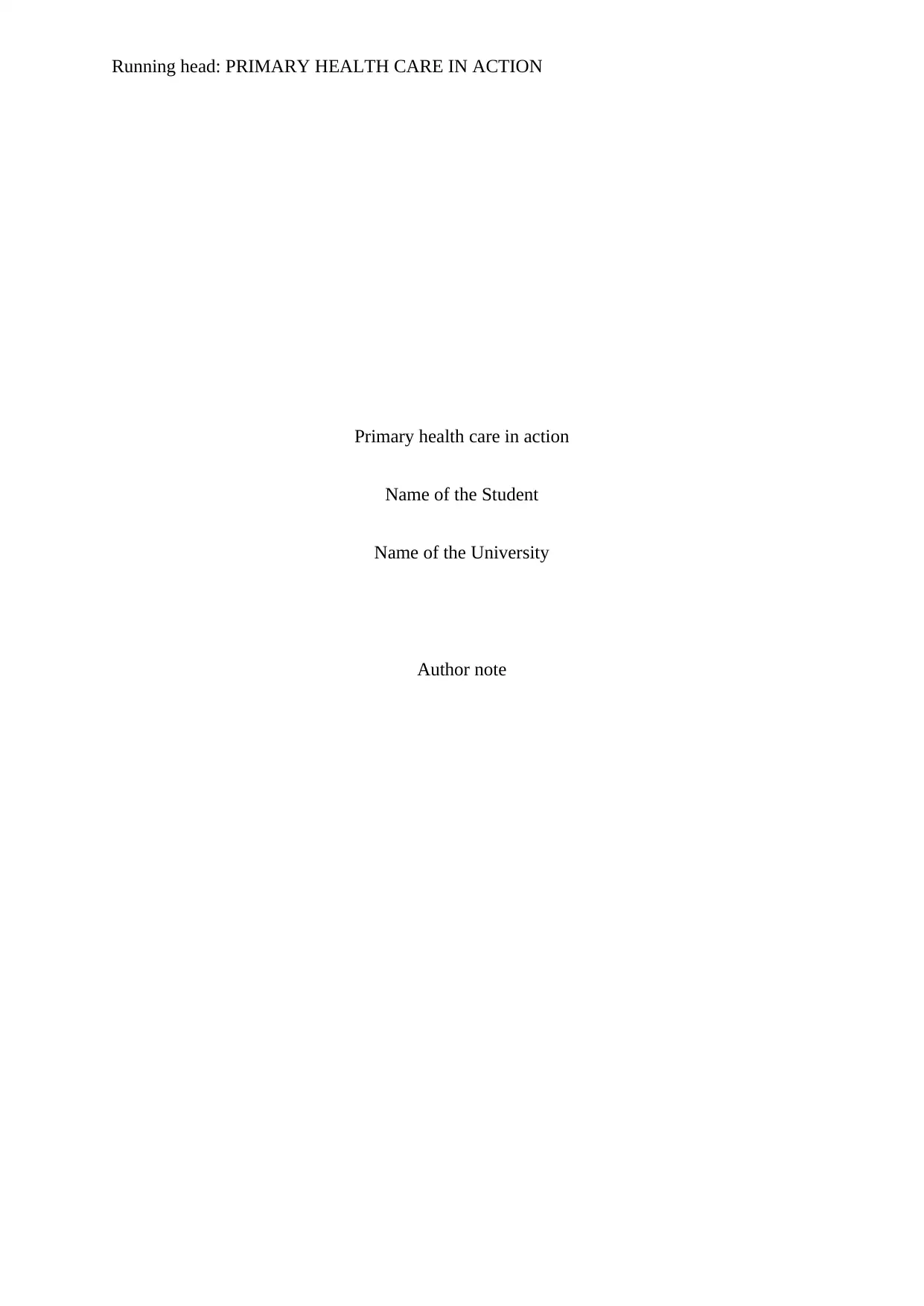
Running head: PRIMARY HEALTH CARE IN ACTION
Primary health care in action
Name of the Student
Name of the University
Author note
Primary health care in action
Name of the Student
Name of the University
Author note
Paraphrase This Document
Need a fresh take? Get an instant paraphrase of this document with our AI Paraphraser
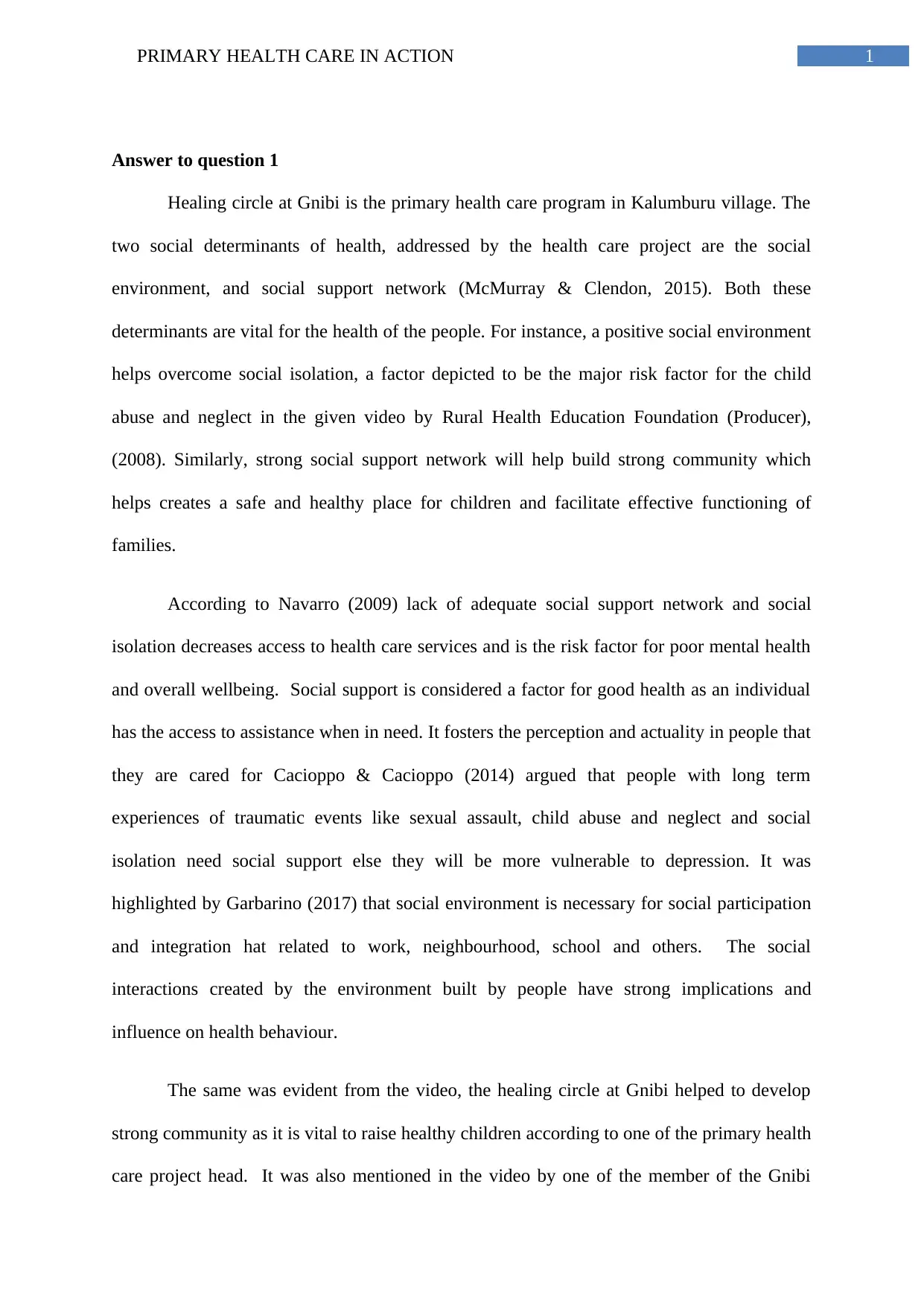
1PRIMARY HEALTH CARE IN ACTION
Answer to question 1
Healing circle at Gnibi is the primary health care program in Kalumburu village. The
two social determinants of health, addressed by the health care project are the social
environment, and social support network (McMurray & Clendon, 2015). Both these
determinants are vital for the health of the people. For instance, a positive social environment
helps overcome social isolation, a factor depicted to be the major risk factor for the child
abuse and neglect in the given video by Rural Health Education Foundation (Producer),
(2008). Similarly, strong social support network will help build strong community which
helps creates a safe and healthy place for children and facilitate effective functioning of
families.
According to Navarro (2009) lack of adequate social support network and social
isolation decreases access to health care services and is the risk factor for poor mental health
and overall wellbeing. Social support is considered a factor for good health as an individual
has the access to assistance when in need. It fosters the perception and actuality in people that
they are cared for Cacioppo & Cacioppo (2014) argued that people with long term
experiences of traumatic events like sexual assault, child abuse and neglect and social
isolation need social support else they will be more vulnerable to depression. It was
highlighted by Garbarino (2017) that social environment is necessary for social participation
and integration hat related to work, neighbourhood, school and others. The social
interactions created by the environment built by people have strong implications and
influence on health behaviour.
The same was evident from the video, the healing circle at Gnibi helped to develop
strong community as it is vital to raise healthy children according to one of the primary health
care project head. It was also mentioned in the video by one of the member of the Gnibi
Answer to question 1
Healing circle at Gnibi is the primary health care program in Kalumburu village. The
two social determinants of health, addressed by the health care project are the social
environment, and social support network (McMurray & Clendon, 2015). Both these
determinants are vital for the health of the people. For instance, a positive social environment
helps overcome social isolation, a factor depicted to be the major risk factor for the child
abuse and neglect in the given video by Rural Health Education Foundation (Producer),
(2008). Similarly, strong social support network will help build strong community which
helps creates a safe and healthy place for children and facilitate effective functioning of
families.
According to Navarro (2009) lack of adequate social support network and social
isolation decreases access to health care services and is the risk factor for poor mental health
and overall wellbeing. Social support is considered a factor for good health as an individual
has the access to assistance when in need. It fosters the perception and actuality in people that
they are cared for Cacioppo & Cacioppo (2014) argued that people with long term
experiences of traumatic events like sexual assault, child abuse and neglect and social
isolation need social support else they will be more vulnerable to depression. It was
highlighted by Garbarino (2017) that social environment is necessary for social participation
and integration hat related to work, neighbourhood, school and others. The social
interactions created by the environment built by people have strong implications and
influence on health behaviour.
The same was evident from the video, the healing circle at Gnibi helped to develop
strong community as it is vital to raise healthy children according to one of the primary health
care project head. It was also mentioned in the video by one of the member of the Gnibi
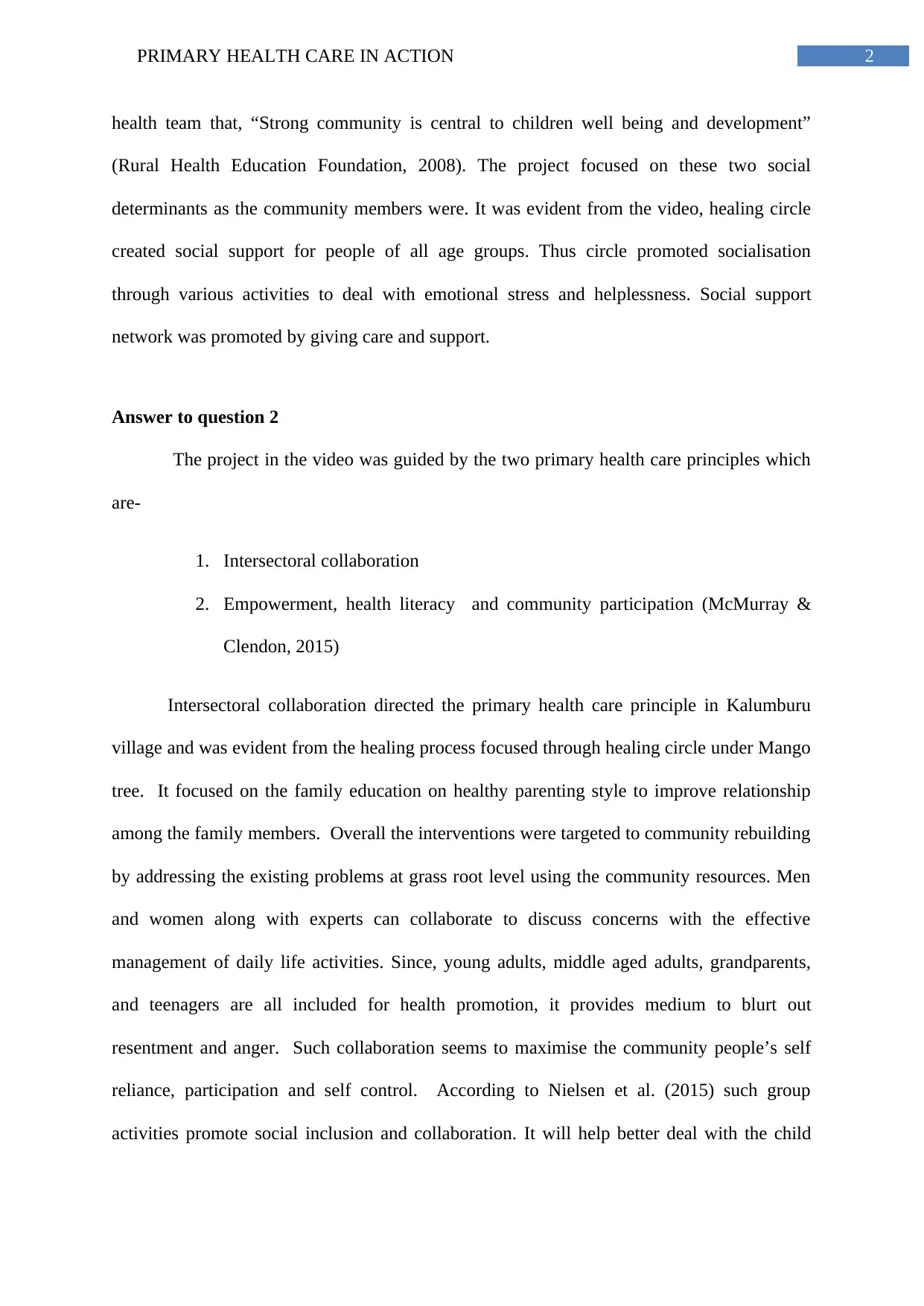
2PRIMARY HEALTH CARE IN ACTION
health team that, “Strong community is central to children well being and development”
(Rural Health Education Foundation, 2008). The project focused on these two social
determinants as the community members were. It was evident from the video, healing circle
created social support for people of all age groups. Thus circle promoted socialisation
through various activities to deal with emotional stress and helplessness. Social support
network was promoted by giving care and support.
Answer to question 2
The project in the video was guided by the two primary health care principles which
are-
1. Intersectoral collaboration
2. Empowerment, health literacy and community participation (McMurray &
Clendon, 2015)
Intersectoral collaboration directed the primary health care principle in Kalumburu
village and was evident from the healing process focused through healing circle under Mango
tree. It focused on the family education on healthy parenting style to improve relationship
among the family members. Overall the interventions were targeted to community rebuilding
by addressing the existing problems at grass root level using the community resources. Men
and women along with experts can collaborate to discuss concerns with the effective
management of daily life activities. Since, young adults, middle aged adults, grandparents,
and teenagers are all included for health promotion, it provides medium to blurt out
resentment and anger. Such collaboration seems to maximise the community people’s self
reliance, participation and self control. According to Nielsen et al. (2015) such group
activities promote social inclusion and collaboration. It will help better deal with the child
health team that, “Strong community is central to children well being and development”
(Rural Health Education Foundation, 2008). The project focused on these two social
determinants as the community members were. It was evident from the video, healing circle
created social support for people of all age groups. Thus circle promoted socialisation
through various activities to deal with emotional stress and helplessness. Social support
network was promoted by giving care and support.
Answer to question 2
The project in the video was guided by the two primary health care principles which
are-
1. Intersectoral collaboration
2. Empowerment, health literacy and community participation (McMurray &
Clendon, 2015)
Intersectoral collaboration directed the primary health care principle in Kalumburu
village and was evident from the healing process focused through healing circle under Mango
tree. It focused on the family education on healthy parenting style to improve relationship
among the family members. Overall the interventions were targeted to community rebuilding
by addressing the existing problems at grass root level using the community resources. Men
and women along with experts can collaborate to discuss concerns with the effective
management of daily life activities. Since, young adults, middle aged adults, grandparents,
and teenagers are all included for health promotion, it provides medium to blurt out
resentment and anger. Such collaboration seems to maximise the community people’s self
reliance, participation and self control. According to Nielsen et al. (2015) such group
activities promote social inclusion and collaboration. It will help better deal with the child
⊘ This is a preview!⊘
Do you want full access?
Subscribe today to unlock all pages.

Trusted by 1+ million students worldwide
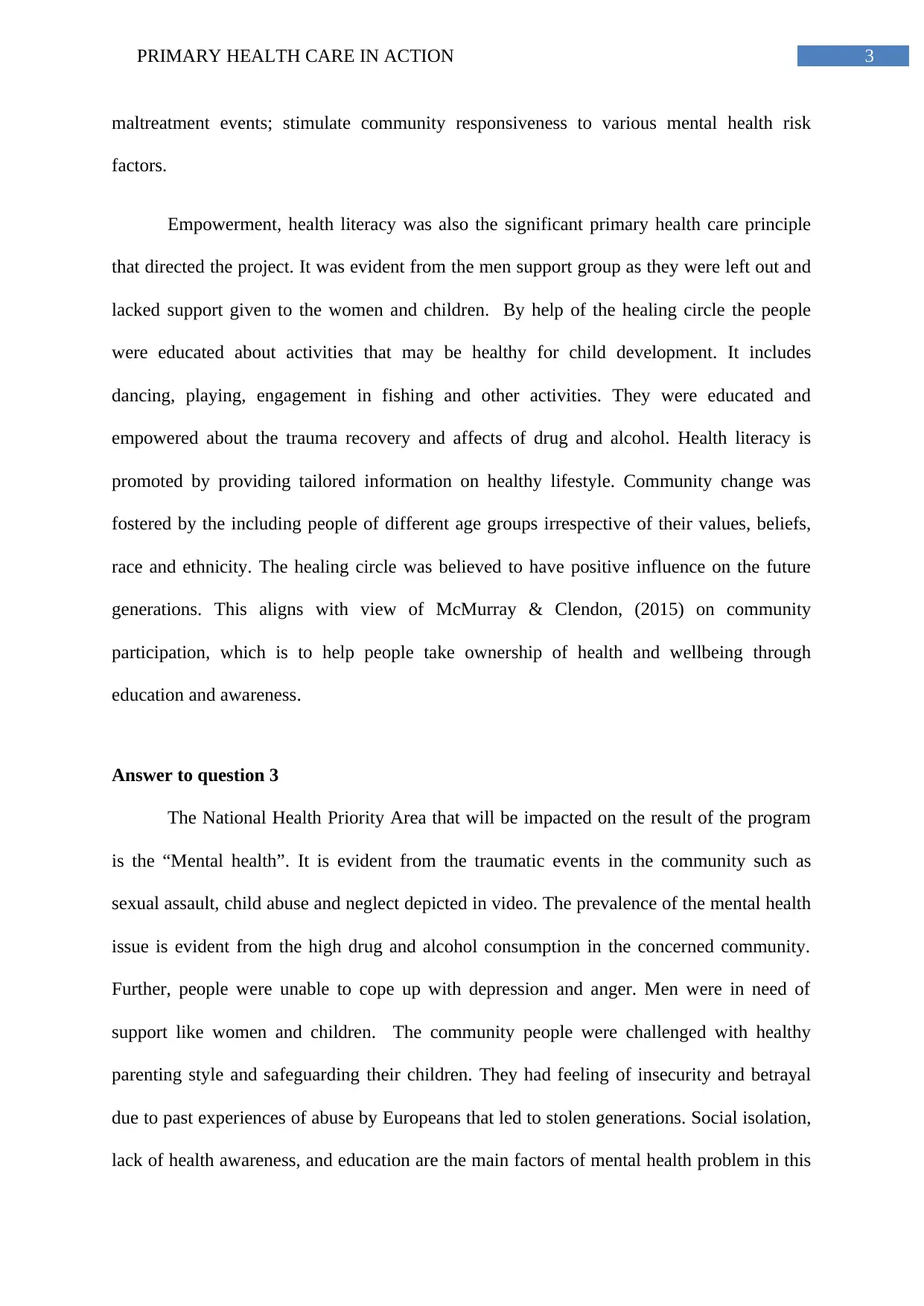
3PRIMARY HEALTH CARE IN ACTION
maltreatment events; stimulate community responsiveness to various mental health risk
factors.
Empowerment, health literacy was also the significant primary health care principle
that directed the project. It was evident from the men support group as they were left out and
lacked support given to the women and children. By help of the healing circle the people
were educated about activities that may be healthy for child development. It includes
dancing, playing, engagement in fishing and other activities. They were educated and
empowered about the trauma recovery and affects of drug and alcohol. Health literacy is
promoted by providing tailored information on healthy lifestyle. Community change was
fostered by the including people of different age groups irrespective of their values, beliefs,
race and ethnicity. The healing circle was believed to have positive influence on the future
generations. This aligns with view of McMurray & Clendon, (2015) on community
participation, which is to help people take ownership of health and wellbeing through
education and awareness.
Answer to question 3
The National Health Priority Area that will be impacted on the result of the program
is the “Mental health”. It is evident from the traumatic events in the community such as
sexual assault, child abuse and neglect depicted in video. The prevalence of the mental health
issue is evident from the high drug and alcohol consumption in the concerned community.
Further, people were unable to cope up with depression and anger. Men were in need of
support like women and children. The community people were challenged with healthy
parenting style and safeguarding their children. They had feeling of insecurity and betrayal
due to past experiences of abuse by Europeans that led to stolen generations. Social isolation,
lack of health awareness, and education are the main factors of mental health problem in this
maltreatment events; stimulate community responsiveness to various mental health risk
factors.
Empowerment, health literacy was also the significant primary health care principle
that directed the project. It was evident from the men support group as they were left out and
lacked support given to the women and children. By help of the healing circle the people
were educated about activities that may be healthy for child development. It includes
dancing, playing, engagement in fishing and other activities. They were educated and
empowered about the trauma recovery and affects of drug and alcohol. Health literacy is
promoted by providing tailored information on healthy lifestyle. Community change was
fostered by the including people of different age groups irrespective of their values, beliefs,
race and ethnicity. The healing circle was believed to have positive influence on the future
generations. This aligns with view of McMurray & Clendon, (2015) on community
participation, which is to help people take ownership of health and wellbeing through
education and awareness.
Answer to question 3
The National Health Priority Area that will be impacted on the result of the program
is the “Mental health”. It is evident from the traumatic events in the community such as
sexual assault, child abuse and neglect depicted in video. The prevalence of the mental health
issue is evident from the high drug and alcohol consumption in the concerned community.
Further, people were unable to cope up with depression and anger. Men were in need of
support like women and children. The community people were challenged with healthy
parenting style and safeguarding their children. They had feeling of insecurity and betrayal
due to past experiences of abuse by Europeans that led to stolen generations. Social isolation,
lack of health awareness, and education are the main factors of mental health problem in this
Paraphrase This Document
Need a fresh take? Get an instant paraphrase of this document with our AI Paraphraser
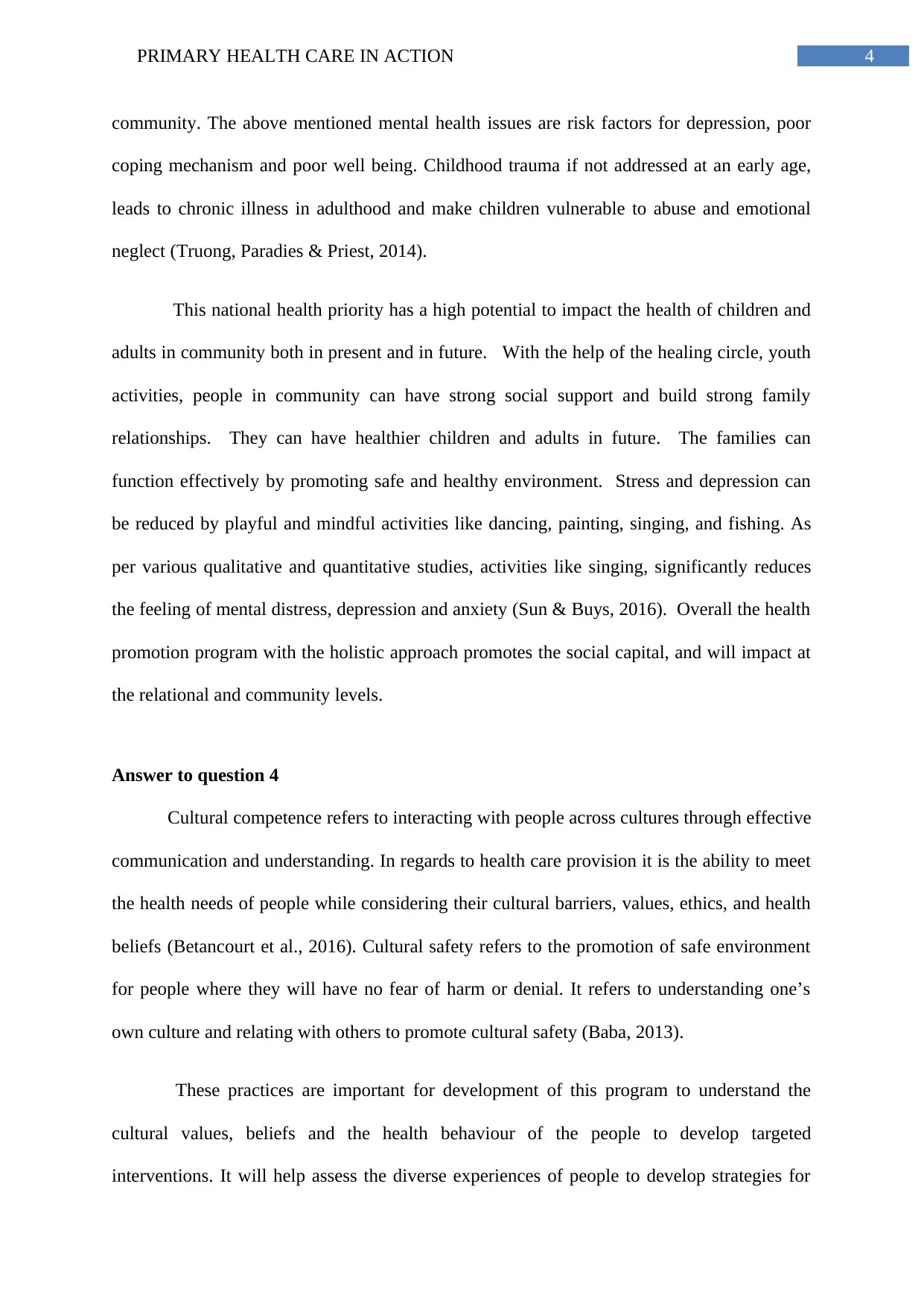
4PRIMARY HEALTH CARE IN ACTION
community. The above mentioned mental health issues are risk factors for depression, poor
coping mechanism and poor well being. Childhood trauma if not addressed at an early age,
leads to chronic illness in adulthood and make children vulnerable to abuse and emotional
neglect (Truong, Paradies & Priest, 2014).
This national health priority has a high potential to impact the health of children and
adults in community both in present and in future. With the help of the healing circle, youth
activities, people in community can have strong social support and build strong family
relationships. They can have healthier children and adults in future. The families can
function effectively by promoting safe and healthy environment. Stress and depression can
be reduced by playful and mindful activities like dancing, painting, singing, and fishing. As
per various qualitative and quantitative studies, activities like singing, significantly reduces
the feeling of mental distress, depression and anxiety (Sun & Buys, 2016). Overall the health
promotion program with the holistic approach promotes the social capital, and will impact at
the relational and community levels.
Answer to question 4
Cultural competence refers to interacting with people across cultures through effective
communication and understanding. In regards to health care provision it is the ability to meet
the health needs of people while considering their cultural barriers, values, ethics, and health
beliefs (Betancourt et al., 2016). Cultural safety refers to the promotion of safe environment
for people where they will have no fear of harm or denial. It refers to understanding one’s
own culture and relating with others to promote cultural safety (Baba, 2013).
These practices are important for development of this program to understand the
cultural values, beliefs and the health behaviour of the people to develop targeted
interventions. It will help assess the diverse experiences of people to develop strategies for
community. The above mentioned mental health issues are risk factors for depression, poor
coping mechanism and poor well being. Childhood trauma if not addressed at an early age,
leads to chronic illness in adulthood and make children vulnerable to abuse and emotional
neglect (Truong, Paradies & Priest, 2014).
This national health priority has a high potential to impact the health of children and
adults in community both in present and in future. With the help of the healing circle, youth
activities, people in community can have strong social support and build strong family
relationships. They can have healthier children and adults in future. The families can
function effectively by promoting safe and healthy environment. Stress and depression can
be reduced by playful and mindful activities like dancing, painting, singing, and fishing. As
per various qualitative and quantitative studies, activities like singing, significantly reduces
the feeling of mental distress, depression and anxiety (Sun & Buys, 2016). Overall the health
promotion program with the holistic approach promotes the social capital, and will impact at
the relational and community levels.
Answer to question 4
Cultural competence refers to interacting with people across cultures through effective
communication and understanding. In regards to health care provision it is the ability to meet
the health needs of people while considering their cultural barriers, values, ethics, and health
beliefs (Betancourt et al., 2016). Cultural safety refers to the promotion of safe environment
for people where they will have no fear of harm or denial. It refers to understanding one’s
own culture and relating with others to promote cultural safety (Baba, 2013).
These practices are important for development of this program to understand the
cultural values, beliefs and the health behaviour of the people to develop targeted
interventions. It will help assess the diverse experiences of people to develop strategies for
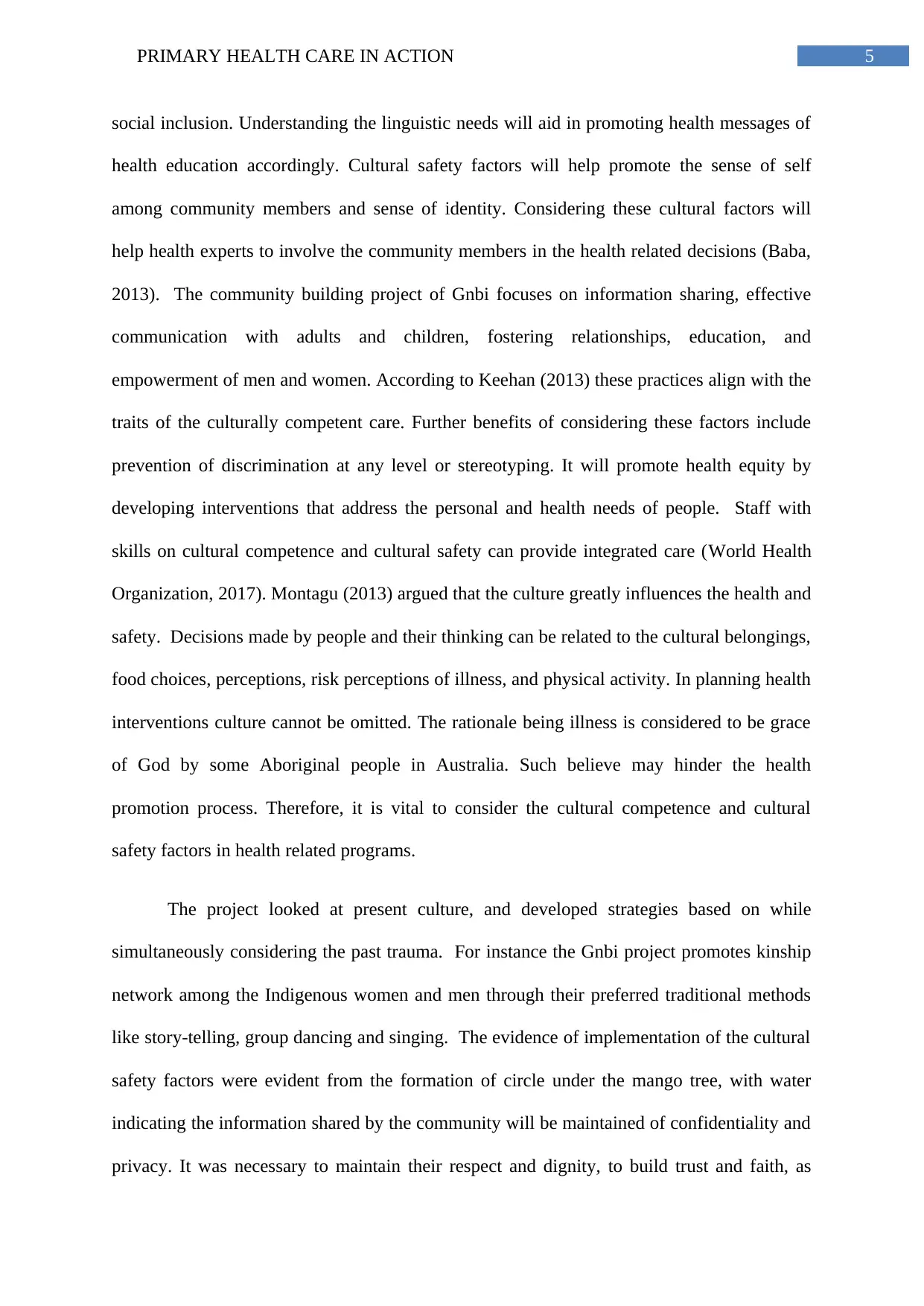
5PRIMARY HEALTH CARE IN ACTION
social inclusion. Understanding the linguistic needs will aid in promoting health messages of
health education accordingly. Cultural safety factors will help promote the sense of self
among community members and sense of identity. Considering these cultural factors will
help health experts to involve the community members in the health related decisions (Baba,
2013). The community building project of Gnbi focuses on information sharing, effective
communication with adults and children, fostering relationships, education, and
empowerment of men and women. According to Keehan (2013) these practices align with the
traits of the culturally competent care. Further benefits of considering these factors include
prevention of discrimination at any level or stereotyping. It will promote health equity by
developing interventions that address the personal and health needs of people. Staff with
skills on cultural competence and cultural safety can provide integrated care (World Health
Organization, 2017). Montagu (2013) argued that the culture greatly influences the health and
safety. Decisions made by people and their thinking can be related to the cultural belongings,
food choices, perceptions, risk perceptions of illness, and physical activity. In planning health
interventions culture cannot be omitted. The rationale being illness is considered to be grace
of God by some Aboriginal people in Australia. Such believe may hinder the health
promotion process. Therefore, it is vital to consider the cultural competence and cultural
safety factors in health related programs.
The project looked at present culture, and developed strategies based on while
simultaneously considering the past trauma. For instance the Gnbi project promotes kinship
network among the Indigenous women and men through their preferred traditional methods
like story-telling, group dancing and singing. The evidence of implementation of the cultural
safety factors were evident from the formation of circle under the mango tree, with water
indicating the information shared by the community will be maintained of confidentiality and
privacy. It was necessary to maintain their respect and dignity, to build trust and faith, as
social inclusion. Understanding the linguistic needs will aid in promoting health messages of
health education accordingly. Cultural safety factors will help promote the sense of self
among community members and sense of identity. Considering these cultural factors will
help health experts to involve the community members in the health related decisions (Baba,
2013). The community building project of Gnbi focuses on information sharing, effective
communication with adults and children, fostering relationships, education, and
empowerment of men and women. According to Keehan (2013) these practices align with the
traits of the culturally competent care. Further benefits of considering these factors include
prevention of discrimination at any level or stereotyping. It will promote health equity by
developing interventions that address the personal and health needs of people. Staff with
skills on cultural competence and cultural safety can provide integrated care (World Health
Organization, 2017). Montagu (2013) argued that the culture greatly influences the health and
safety. Decisions made by people and their thinking can be related to the cultural belongings,
food choices, perceptions, risk perceptions of illness, and physical activity. In planning health
interventions culture cannot be omitted. The rationale being illness is considered to be grace
of God by some Aboriginal people in Australia. Such believe may hinder the health
promotion process. Therefore, it is vital to consider the cultural competence and cultural
safety factors in health related programs.
The project looked at present culture, and developed strategies based on while
simultaneously considering the past trauma. For instance the Gnbi project promotes kinship
network among the Indigenous women and men through their preferred traditional methods
like story-telling, group dancing and singing. The evidence of implementation of the cultural
safety factors were evident from the formation of circle under the mango tree, with water
indicating the information shared by the community will be maintained of confidentiality and
privacy. It was necessary to maintain their respect and dignity, to build trust and faith, as
⊘ This is a preview!⊘
Do you want full access?
Subscribe today to unlock all pages.

Trusted by 1+ million students worldwide
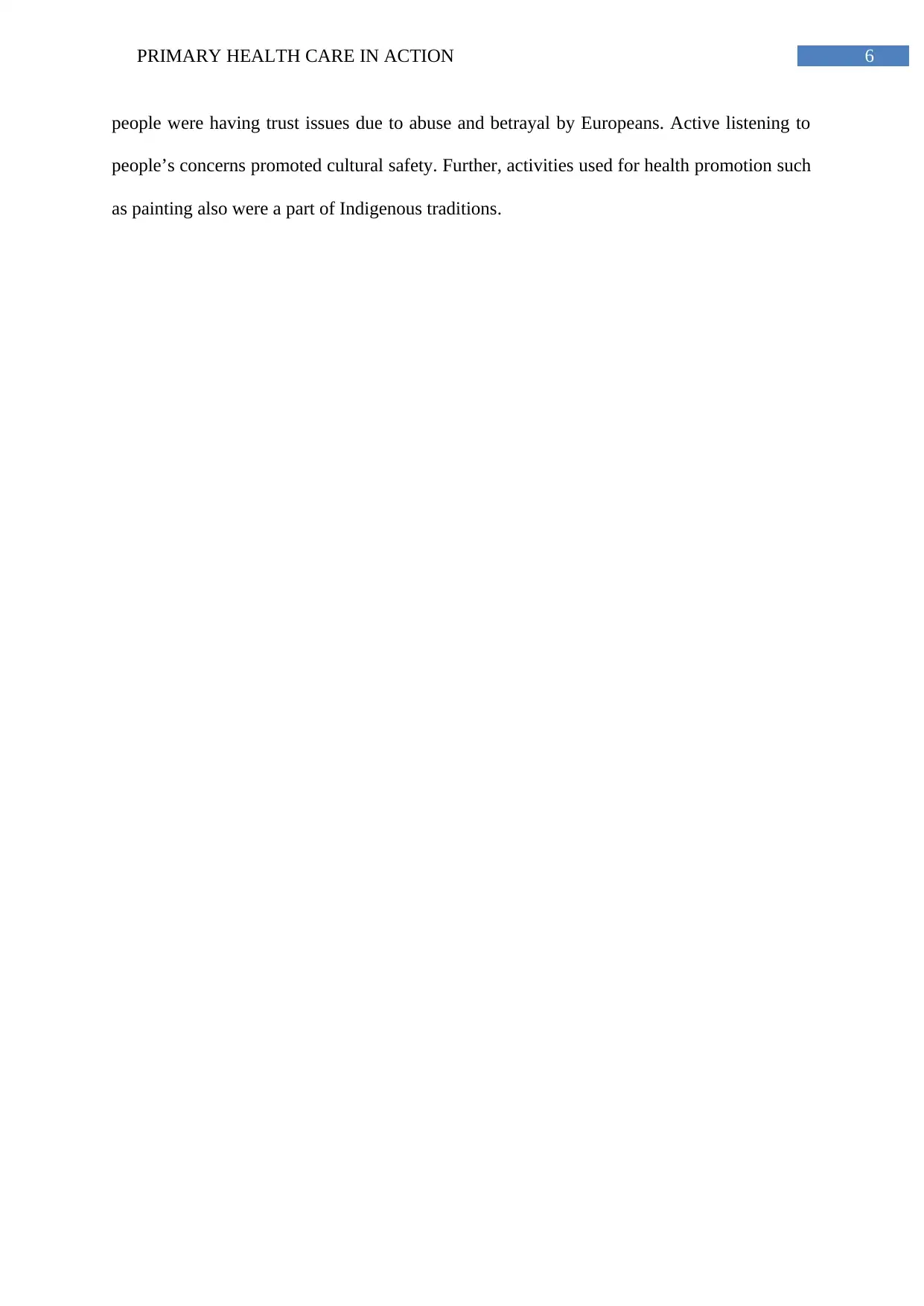
6PRIMARY HEALTH CARE IN ACTION
people were having trust issues due to abuse and betrayal by Europeans. Active listening to
people’s concerns promoted cultural safety. Further, activities used for health promotion such
as painting also were a part of Indigenous traditions.
people were having trust issues due to abuse and betrayal by Europeans. Active listening to
people’s concerns promoted cultural safety. Further, activities used for health promotion such
as painting also were a part of Indigenous traditions.
Paraphrase This Document
Need a fresh take? Get an instant paraphrase of this document with our AI Paraphraser
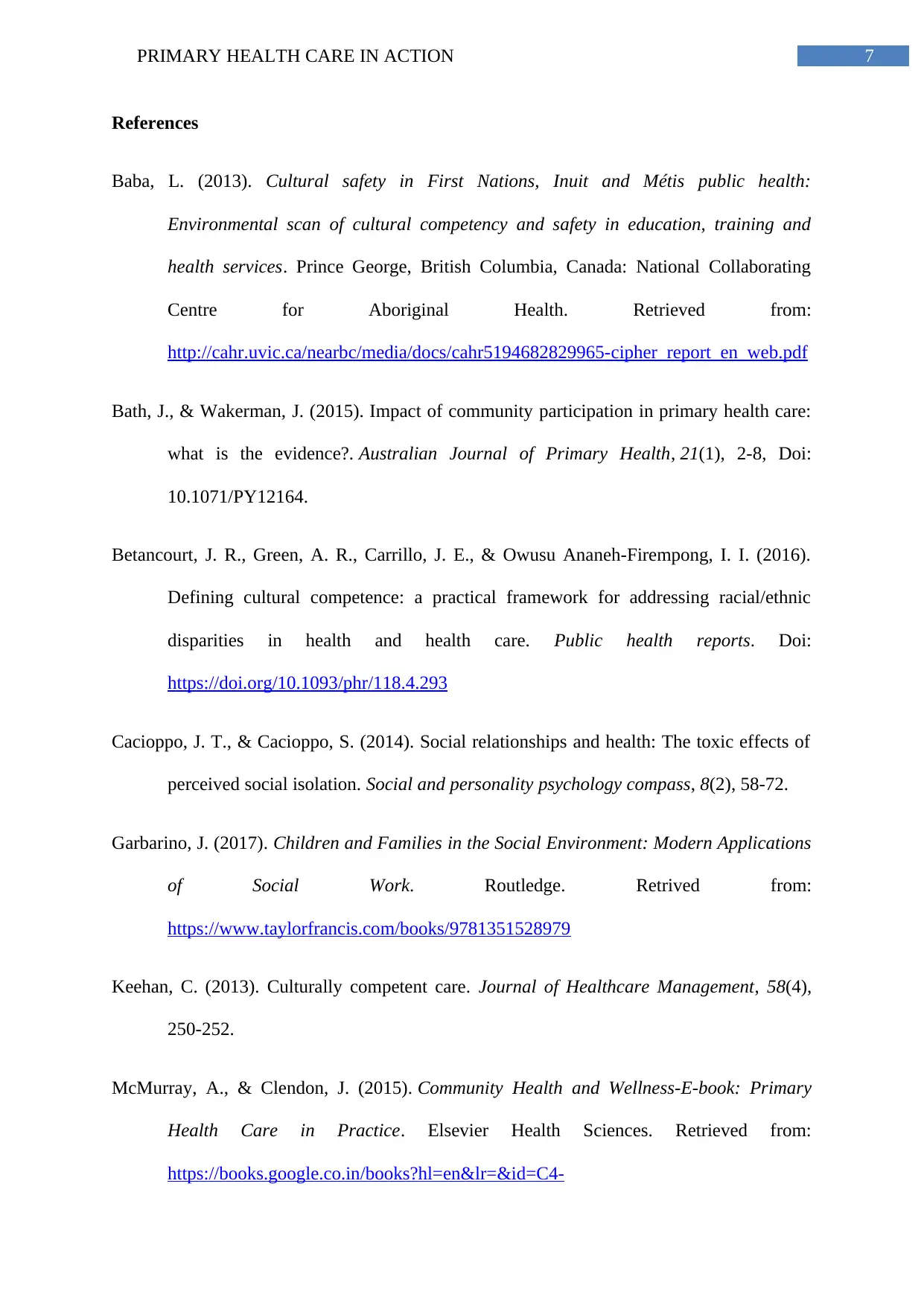
7PRIMARY HEALTH CARE IN ACTION
References
Baba, L. (2013). Cultural safety in First Nations, Inuit and Métis public health:
Environmental scan of cultural competency and safety in education, training and
health services. Prince George, British Columbia, Canada: National Collaborating
Centre for Aboriginal Health. Retrieved from:
http://cahr.uvic.ca/nearbc/media/docs/cahr5194682829965-cipher_report_en_web.pdf
Bath, J., & Wakerman, J. (2015). Impact of community participation in primary health care:
what is the evidence?. Australian Journal of Primary Health, 21(1), 2-8, Doi:
10.1071/PY12164.
Betancourt, J. R., Green, A. R., Carrillo, J. E., & Owusu Ananeh-Firempong, I. I. (2016).
Defining cultural competence: a practical framework for addressing racial/ethnic
disparities in health and health care. Public health reports. Doi:
https://doi.org/10.1093/phr/118.4.293
Cacioppo, J. T., & Cacioppo, S. (2014). Social relationships and health: The toxic effects of
perceived social isolation. Social and personality psychology compass, 8(2), 58-72.
Garbarino, J. (2017). Children and Families in the Social Environment: Modern Applications
of Social Work. Routledge. Retrived from:
https://www.taylorfrancis.com/books/9781351528979
Keehan, C. (2013). Culturally competent care. Journal of Healthcare Management, 58(4),
250-252.
McMurray, A., & Clendon, J. (2015). Community Health and Wellness-E-book: Primary
Health Care in Practice. Elsevier Health Sciences. Retrieved from:
https://books.google.co.in/books?hl=en&lr=&id=C4-
References
Baba, L. (2013). Cultural safety in First Nations, Inuit and Métis public health:
Environmental scan of cultural competency and safety in education, training and
health services. Prince George, British Columbia, Canada: National Collaborating
Centre for Aboriginal Health. Retrieved from:
http://cahr.uvic.ca/nearbc/media/docs/cahr5194682829965-cipher_report_en_web.pdf
Bath, J., & Wakerman, J. (2015). Impact of community participation in primary health care:
what is the evidence?. Australian Journal of Primary Health, 21(1), 2-8, Doi:
10.1071/PY12164.
Betancourt, J. R., Green, A. R., Carrillo, J. E., & Owusu Ananeh-Firempong, I. I. (2016).
Defining cultural competence: a practical framework for addressing racial/ethnic
disparities in health and health care. Public health reports. Doi:
https://doi.org/10.1093/phr/118.4.293
Cacioppo, J. T., & Cacioppo, S. (2014). Social relationships and health: The toxic effects of
perceived social isolation. Social and personality psychology compass, 8(2), 58-72.
Garbarino, J. (2017). Children and Families in the Social Environment: Modern Applications
of Social Work. Routledge. Retrived from:
https://www.taylorfrancis.com/books/9781351528979
Keehan, C. (2013). Culturally competent care. Journal of Healthcare Management, 58(4),
250-252.
McMurray, A., & Clendon, J. (2015). Community Health and Wellness-E-book: Primary
Health Care in Practice. Elsevier Health Sciences. Retrieved from:
https://books.google.co.in/books?hl=en&lr=&id=C4-
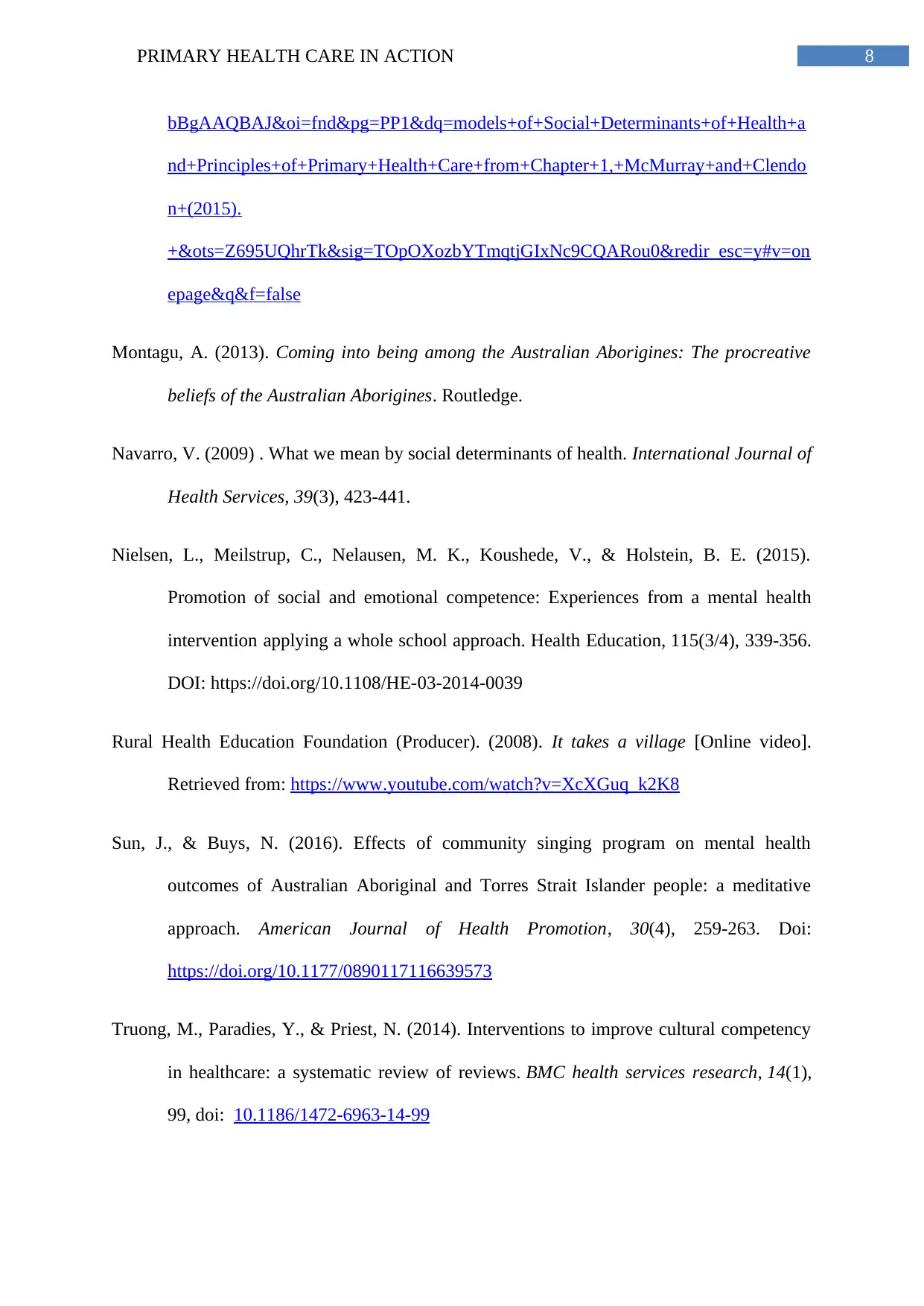
8PRIMARY HEALTH CARE IN ACTION
bBgAAQBAJ&oi=fnd&pg=PP1&dq=models+of+Social+Determinants+of+Health+a
nd+Principles+of+Primary+Health+Care+from+Chapter+1,+McMurray+and+Clendo
n+(2015).
+&ots=Z695UQhrTk&sig=TOpOXozbYTmqtjGIxNc9CQARou0&redir_esc=y#v=on
epage&q&f=false
Montagu, A. (2013). Coming into being among the Australian Aborigines: The procreative
beliefs of the Australian Aborigines. Routledge.
Navarro, V. (2009) . What we mean by social determinants of health. International Journal of
Health Services, 39(3), 423-441.
Nielsen, L., Meilstrup, C., Nelausen, M. K., Koushede, V., & Holstein, B. E. (2015).
Promotion of social and emotional competence: Experiences from a mental health
intervention applying a whole school approach. Health Education, 115(3/4), 339-356.
DOI: https://doi.org/10.1108/HE-03-2014-0039
Rural Health Education Foundation (Producer). (2008). It takes a village [Online video].
Retrieved from: https://www.youtube.com/watch?v=XcXGuq_k2K8
Sun, J., & Buys, N. (2016). Effects of community singing program on mental health
outcomes of Australian Aboriginal and Torres Strait Islander people: a meditative
approach. American Journal of Health Promotion, 30(4), 259-263. Doi:
https://doi.org/10.1177/0890117116639573
Truong, M., Paradies, Y., & Priest, N. (2014). Interventions to improve cultural competency
in healthcare: a systematic review of reviews. BMC health services research, 14(1),
99, doi: 10.1186/1472-6963-14-99
bBgAAQBAJ&oi=fnd&pg=PP1&dq=models+of+Social+Determinants+of+Health+a
nd+Principles+of+Primary+Health+Care+from+Chapter+1,+McMurray+and+Clendo
n+(2015).
+&ots=Z695UQhrTk&sig=TOpOXozbYTmqtjGIxNc9CQARou0&redir_esc=y#v=on
epage&q&f=false
Montagu, A. (2013). Coming into being among the Australian Aborigines: The procreative
beliefs of the Australian Aborigines. Routledge.
Navarro, V. (2009) . What we mean by social determinants of health. International Journal of
Health Services, 39(3), 423-441.
Nielsen, L., Meilstrup, C., Nelausen, M. K., Koushede, V., & Holstein, B. E. (2015).
Promotion of social and emotional competence: Experiences from a mental health
intervention applying a whole school approach. Health Education, 115(3/4), 339-356.
DOI: https://doi.org/10.1108/HE-03-2014-0039
Rural Health Education Foundation (Producer). (2008). It takes a village [Online video].
Retrieved from: https://www.youtube.com/watch?v=XcXGuq_k2K8
Sun, J., & Buys, N. (2016). Effects of community singing program on mental health
outcomes of Australian Aboriginal and Torres Strait Islander people: a meditative
approach. American Journal of Health Promotion, 30(4), 259-263. Doi:
https://doi.org/10.1177/0890117116639573
Truong, M., Paradies, Y., & Priest, N. (2014). Interventions to improve cultural competency
in healthcare: a systematic review of reviews. BMC health services research, 14(1),
99, doi: 10.1186/1472-6963-14-99
⊘ This is a preview!⊘
Do you want full access?
Subscribe today to unlock all pages.

Trusted by 1+ million students worldwide

9PRIMARY HEALTH CARE IN ACTION
World Health Organization(2017).Chapter7:Health Systems: principled integrated
care.Accessed from http://www.who.int/whr/2003/chapter7/en/index1.h
World Health Organization(2017).Chapter7:Health Systems: principled integrated
care.Accessed from http://www.who.int/whr/2003/chapter7/en/index1.h
1 out of 10
Related Documents
Your All-in-One AI-Powered Toolkit for Academic Success.
+13062052269
info@desklib.com
Available 24*7 on WhatsApp / Email
![[object Object]](/_next/static/media/star-bottom.7253800d.svg)
Unlock your academic potential
Copyright © 2020–2025 A2Z Services. All Rights Reserved. Developed and managed by ZUCOL.





